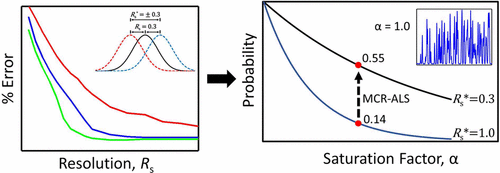当前位置:
X-MOL 学术
›
Anal. Chem.
›
论文详情
Our official English website, www.x-mol.net, welcomes your feedback! (Note: you will need to create a separate account there.)
Determining the Probability of Achieving a Successful Quantitative Analysis for Gas Chromatography–Mass Spectrometry
Analytical Chemistry ( IF 7.4 ) Pub Date : 2017-09-07 00:00:00 , DOI: 10.1021/acs.analchem.7b02230 David K. Pinkerton 1 , Brooke C. Reaser 1 , Kelsey L. Berrier 1 , Robert E. Synovec 1
Analytical Chemistry ( IF 7.4 ) Pub Date : 2017-09-07 00:00:00 , DOI: 10.1021/acs.analchem.7b02230 David K. Pinkerton 1 , Brooke C. Reaser 1 , Kelsey L. Berrier 1 , Robert E. Synovec 1
Affiliation

|
A new approach is presented to determine the probability of achieving a successful quantitative analysis for gas chromatography coupled with mass spectrometry (GC–MS). The proposed theory is based upon a probabilistic description of peak overlap in GC–MS separations to determine the probability of obtaining a successful quantitative analysis, which has its lower limit of chromatographic resolution Rs at some minimum chemometric resolution, Rs*; that is to say, successful quantitative analysis can be achieved when Rs ≥ Rs*. The value of Rs* must be experimentally determined and is dependent on the chemometric method to be applied. The approach presented makes use of the assumption that analyte peaks are independent and randomly distributed across the separation space or are at least locally random, namely, that each analyte represents an independent Bernoulli random variable, which is then used to predict the binomial probability of successful quantitative analysis. The theoretical framework is based on the chromatographic-saturation factor and chemometric-enhanced peak capacity. For a given separation, the probability of quantitative success can be improved via two pathways, a chromatographic-efficiency pathway that reduces the saturation of the sample and a chemometric pathway that reduces Rs* and improves the chemometric-enhanced peak capacity. This theory is demonstrated through a simulation-based study to approximate the resolution limit, Rs*, of multivariate curve resolution-alternating least-squares (MCR-ALS). For this study, Rs* was determined to be ∼0.3, and depending on the analytical expectations for the quantitative bias and the obtained mass-spectral match value, a lower value of Rs* ∼ 0.2 may be achievable.
中文翻译:

确定成功进行气相色谱-质谱联用定量分析的可能性
提出了一种新方法来确定成功进行气相色谱与质谱联用(GC-MS)定量分析的可能性。提出的理论基于对GC-MS分离中峰重叠的概率描述,以确定获得成功的定量分析的可能性,在某些最小化学计量分辨率R s *下,它具有色谱分辨率R s的下限。也就是说,成功的定量分析时可以实现[R小号≥ [R小号*。R s的值*必须通过实验确定,并取决于要应用的化学计量方法。提出的方法利用以下假设:分析物峰是独立的并且在整个分离空间内随机分布,或者至少是局部随机的,即每种分析物代表一个独立的伯努利随机变量,然后将其用于预测成功的二项式概率。定量分析。理论框架基于色谱饱和度因子和化学计量增强的峰容量。对于给定的分离,可以通过两种途径提高定量成功的可能性,一种是降低样品饱和度的色谱效率途径,另一种是降低R s的化学计量途径。*并提高化学计量增强的峰容量。通过基于模拟的研究证明了该理论,以近似多元曲线分辨率交替最小二乘(MCR-ALS)的分辨率极限R s *。对于本研究,R s *被确定为〜0.3,并且取决于对定量偏差的分析期望和所获得的质谱匹配值,可以实现较低的R s *〜0.2。
更新日期:2017-09-07
中文翻译:

确定成功进行气相色谱-质谱联用定量分析的可能性
提出了一种新方法来确定成功进行气相色谱与质谱联用(GC-MS)定量分析的可能性。提出的理论基于对GC-MS分离中峰重叠的概率描述,以确定获得成功的定量分析的可能性,在某些最小化学计量分辨率R s *下,它具有色谱分辨率R s的下限。也就是说,成功的定量分析时可以实现[R小号≥ [R小号*。R s的值*必须通过实验确定,并取决于要应用的化学计量方法。提出的方法利用以下假设:分析物峰是独立的并且在整个分离空间内随机分布,或者至少是局部随机的,即每种分析物代表一个独立的伯努利随机变量,然后将其用于预测成功的二项式概率。定量分析。理论框架基于色谱饱和度因子和化学计量增强的峰容量。对于给定的分离,可以通过两种途径提高定量成功的可能性,一种是降低样品饱和度的色谱效率途径,另一种是降低R s的化学计量途径。*并提高化学计量增强的峰容量。通过基于模拟的研究证明了该理论,以近似多元曲线分辨率交替最小二乘(MCR-ALS)的分辨率极限R s *。对于本研究,R s *被确定为〜0.3,并且取决于对定量偏差的分析期望和所获得的质谱匹配值,可以实现较低的R s *〜0.2。


























 京公网安备 11010802027423号
京公网安备 11010802027423号